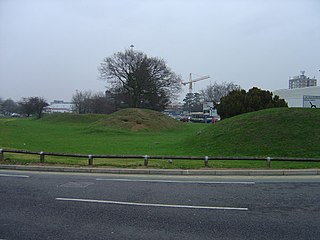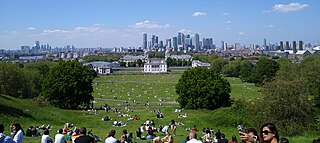This article needs additional citations for verification .(September 2009) |

Winn's Common is a public open space in Plumstead in the Royal Borough of Greenwich, England.
This article needs additional citations for verification .(September 2009) |

Winn's Common is a public open space in Plumstead in the Royal Borough of Greenwich, England.

Winn's Common is said to have been settled by ancient Britons. Several Bronze Age burial mounds were found in the area, [1] as well as Roman relics. One mound remains on Winn's Common, the Winn's Common Tumulus.
During World War II a line of barrage balloons were sited on Winn's Common to deter enemy aircraft from attacking the Royal Arsenal, Woolwich.


Across Kings Highway there is a memorial to George Webb, the headmaster of Burrage Grove Boys School in 1896. Originally a drinking fountain, it has been filled in and its fittings removed. At the end of the second world war many prefabricated houses were placed on Winn's Common to try to alleviate the displaced from all over London. The prefabs came down in the late 1950s to be replaced by open ground and football pitches. An old hut at the North End of the common, adjacent to Kings Highway, served as the changing rooms with a tin trough and cold taps supplying the only washing facility.

Rædwald, also written as Raedwald or Redwald, was a king of East Anglia, an Anglo-Saxon kingdom which included the present-day English counties of Norfolk and Suffolk. He was the son of Tytila of East Anglia and a member of the Wuffingas dynasty, who were the first kings of the East Angles. Details about Rædwald's reign are scarce, primarily because the Viking invasions of the 9th century destroyed the monasteries in East Anglia where many documents would have been kept. Rædwald reigned from about 599 until his death around 624, initially under the overlordship of Æthelberht of Kent. In 616, as a result of fighting the Battle of the River Idle and defeating Æthelfrith of Northumbria, he was able to install Edwin, who was acquiescent to his authority, as the new king of Northumbria. During the battle, both Æthelfrith and Rædwald's son, Rægenhere, were killed.

Plumstead is an area in southeast London, within the Royal Borough of Greenwich, England. It is located east of Woolwich.

Woolwich is a district in southeast London, England, within the Royal Borough of Greenwich.

Sutton Hoo is the site of two early medieval cemeteries dating from the 6th to 7th centuries near the English town of Woodbridge. Archaeologists have been excavating the area since 1938, when a previously undisturbed ship burial containing a wealth of Anglo-Saxon artefacts was discovered. The site is important in establishing the history of the Anglo-Saxon kingdom of East Anglia as well as illuminating the Anglo-Saxons during a period which lacks historical documentation.

A kurgan is a type of tumulus constructed over a grave, often characterized by containing a single human body along with grave vessels, weapons and horses. Originally in use on the Pontic–Caspian steppe, kurgans spread into much of Central Asia and Eastern, Southeast, Western and Northern Europe during the 3rd millennium BC.

The Hill of Tara is a hill and ancient ceremonial and burial site near Skryne in County Meath, Ireland. Tradition identifies the hill as the inauguration place and seat of the High Kings of Ireland; it also appears in Irish mythology. Tara consists of numerous monuments and earthworks—dating from the Neolithic to the Iron Age—including a passage tomb, burial mounds, round enclosures, a standing stone, and a ceremonial avenue. There is also a church and graveyard on the hill. Tara forms part of a larger ancient landscape and Tara itself is a protected national monument under the care of the Office of Public Works, an agency of the Irish Government.

A tumulus is a mound of earth and stones raised over a grave or graves. Tumuli are also known as barrows, burial mounds or kurgans, and may be found throughout much of the world. A cairn, which is a mound of stones built for various purposes, may also originally have been a tumulus.

The Six Hills are a collection of Roman barrows situated alongside the old Great North Road on Six Hills Common in Stevenage, Hertfordshire, England. They are classed as a Scheduled Ancient Monument and are protected by law. They form the largest surviving Roman barrow group in England. Beside their historical significance, they lend their name to an important thoroughfare in the town and are a local landmark.

Witley Common is an area of woodland and heath, close to Witley, Surrey, in the United Kingdom. It is part of a much larger Site of Special Scientific Interest.

Plumstead Common is a common and urban park in Plumstead in the Royal Borough of Greenwich (SE18), south-east London. It is part of the South East London Green Chain.

The Royal Borough of Greenwich has over fifty parks and open spaces within its boundaries. They include:

Chipperfield is a village and civil parish in the Dacorum district of Hertfordshire, England, approximately five miles southwest of Hemel Hempstead and five miles north of Watford. It stands on a chalk plateau at the edge of the Chiltern Hills, between 130 and 160 metres above sea level.

The Manor Ground located in Plumstead, south east London was a football stadium. This arena was the home of football club Royal Arsenal, which was later named Woolwich Arsenal, and as so came to be known as Arsenal F.C.

The A209 road is a 2-mile (3.2 km) route in southeast London, England. It connects Plumstead in the north with Welling in the south, passing through East Wickham. It is known as Wickham Lane at the northern end in the Royal Borough of Greenwich and Upper Wickham Lane at the southern end in the London Borough of Bexley. The entire route is served by the London Buses route 96.

The Ridgeway is a 3.5-mile (5.6 km) "cycling permitted pedestrian priority" footpath owned by Thames Water in southeast London. It runs between Plumstead and Crossness on an embankment that covers the Joseph Bazalgette Southern Outfall Sewer.

New Southgate Cemetery is a 22-hectare cemetery in Brunswick Park in the London Borough of Barnet. It was established by the Colney Hatch Company in the 1850s and became the Great Northern London Cemetery, with a railway service running from near Kings Cross station to a dedicated station at the cemetery, similar to the service of the London Necropolis Company to Brookwood Cemetery in Surrey.

Plumstead Manor School is a coeducational secondary school and sixth form located next to Plumstead Common in the Plumstead area of the Royal Borough of Greenwich in London, England. It is a community school administered by Greenwich London Borough Council.

Woolwich cemetery is a cemetery in southeast London, situated south-east of Woolwich, in Kings Highway, Plumstead, on land that was formerly part of Plumstead Common. The first cemetery, which is sometimes referred to as the Woolwich Old Cemetery, was opened in 1856 by the Woolwich Burial Board and the 12-acre site was almost full within 30 years; in 1885, a new cemetery was established on adjacent land to the east. The latter site is still in use, and contains graves of those who died in explosions at the Royal Arsenal, plus a World War I memorial with the names of 14 casualties; in total the cemetery has 96 World War I and 81 World War II Commonwealth war graves.

Plumstead Cemetery is a cemetery in Plumstead, southeast London. It is situated south-east of Woolwich, to the north of Wickham Lane, west of Lodge Hill, and south of Bostall Wood.

Shrewsbury Barrow is a Bronze Age burial mound in Shooter's Hill in South East London, in the Royal Borough of Greenwich. It is a Scheduled Monument.
![]() Media related to Winn's Common at Wikimedia Commons
Media related to Winn's Common at Wikimedia Commons